Nikon D5200 Review
Nikon D5200 Introduction
The Nikon D5200 is an upper-entry-level DSLR with a state-of-the-art 24 megapixels CMOS sensor capable of ISO sensitivities from 100 to 25600, plus 2 extra stops for NightVision, and full 1080p HD video recording with stereo sound, either built-in or from an external source. The Nikon D5200 features a high-performance 39-point AF system. It has an electronic-only lens-mount and most functions frequently found among entry-level digital SLRs.
The D5200 is targeted at novice photographers who need fast autofocus in a DSLR with a simple interface. The high-resolution sensor makes it possible to make very large prints while the 5 FPS continuous drive helps to capture fleeting moments.
This detailed digital camera review takes a close look at the Nikon D5200's features, ergonomics, usability, image quality, performance, photographic controls and video recording features.
Nikon D5200 Features
Sensor
- 24 Megapixels CMOS sensor
- APS-C size, 1.5X crop-factor
- Standard ISO 100 - 6400
- Expanded ISO 100 - 25600
- Night Vision B&W up to ISO 102400
- Nikon F-mount without AF-coupling
- Optional Customizable Auto ISO, 200-25600 ISO Limit and 1/2000-1s Minimum Shutter-Speed
Exposure
- 1/4000s - 30s Shutter-Speeds, plus Bulb
- Standard PASM modes with Program-Shift
- Automatic plus 16 Scene and 7 Effects modes
- Multi-Segment, Center-Weighed and Spot metering-modes
- Exposure-Compensation: ±5 in 1/3 or ½ EV steps
- Flash-Compensation: -3..+1 in 1/3 or ½ EV steps
- Flash Modes: Forced, Redeye, Rear-Sync, Slow-Sync, Redeye Slow-Sync
Image Parameters
- Automatic and Preset white-balance, all fine-tunable along 2 axis in 13 steps
- 7 Types of Fluorescent white-balanceSodium-Vapor, Warm White, White, Cool White, Day White, Daylight and Mercury Vapor.
- Custom White-Balance using immediate capture or reference image
- WB Bracketing, 3 frames, 3 step-sizes, 1-axis
- Active D-Lighting Bracketing, 3 frames
- Picture-Control: 5 color & 1 monochrome
- Adjustable Contrast, Saturation and Hue, 7 steps
- Adjustable Brightness, 3 steps
- Adjustable Sharpness, 10 steps
- Optional Distortion Correction
- Optional Active D-Lighting, 4 levels or Auto
- Optional High-ISO Noise-Reduction, 3 levels
- Optional Long-Exposure Noise-Reduction
Focus
- Focus Drive: Single, Continuous, Manual
- 39-Point Phase-Detect autofocus system
- Optional Range-Finder mode
- Optional AF-Assist Lamp
Drive
- 5 FPS Drive, 16 RAW or 100 JPEG max
- AE Bracketing, 3 frames, maximum ±2 EV
- Automatic HDR from 2 frames, 4 tone-mappings
- Multiple-Exposure, 2-3 shots, optional Auto-Gain
- Interval-Timer: 1s-24h delay, 1-999 shots, immediate or delayed
- Self-Timer: 2, 5, 10 or 20s delay, 1-9 frames
- Optional Shutter-Delay mode, fixed at 2s
- Optional IR Remote: Instant or 2s Delay
- Quiet shuter-release
Video
- 1920x1080 @ 30 FPS 1080p HD
- 1920x1080 @ 60 FPS 1080i HD
- 1280x720 @ 60 FPS 720p HD
- 640x480 @ 30 FPS VGA
- Continuous Contrast-Detect AF
- Quicktime H.264 codec, 2 quality levels
- Ajustable Microphone Sensitivity, 20 steps
- Optional Stereo-Sound via built-in microphone
- Optional Stereo-Sound via mini-jack
Viewfinder & Display
- Partial Live-View with Subject Tracking and Face-Detect autofocus
- OVF, 95% coverage, 0.78X magnification
- Rotating 3” LCD with 920K Pixels
- Interactive Status-Display on LCD
Body & Controls
- AE-L/AF-L Button, selectable AEL & AFL, AEL, AFL, AEL Hold and AF-On function
- Customizable Function-Button
- JPEG and RAW modes
- Built-in flash and hot-shoe
- Hardware dust-reduction
- Proprietary Lithium-Ion battery
- SDXC Memory support
Nikon D5200 Capability - What can it do?
The Nikon D5200 is an entry-level DSLR, just a notch above the D3200 reviewed here. In fact, they are almost identical save for the autofocus system and LCD screen. While the D3200 has a standard 11-point AF system, the D5200 offers a 39-point AF system, more than any entry-level DSLR. The D5200 adds flexibility at the risk of fragility with a rotating LCD, while the D3200 has a fixed one.
As always for a DSLR, this one features a high number of photographic controls which are listed above in the introduction. While some professional features are missing, what mostly distinguishes an entry-level DSLR is not the functions themselves but the interface to access them. The ergonomics section below covers this.
Versatility of a DSLR is provided by its lens-mount. Using the Nikon F-mount, the D5200 gains access to one of the largest lens lineups in the industry. The limitation is that this mount has no AF-coupling and so only lenses with a built-in autofocus motor can focus automatically on the D5200. Lenses without a built-in AF motor work but must be focused manually. The D5200 includes a Rangefinder to help focus manually. This mode swaps the exposure indicator in the viewfinder with a focus direction indicator.
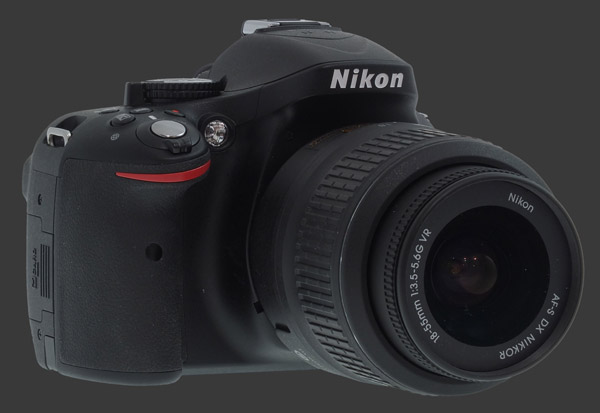
The 24 megapixels CMOS sensor in this digital camera has enough resolution to make large crisp prints up to 18" x 24". Larger prints are easily possible and look good at normal viewing distances. Obviously, a sufficiently good lens is needed to render all those pixels sharply.
This Nikon is suitable for photography in very low-light, both hand-held or with a tripod. With an ISO sensitivity range expandable until 25600 and monochrome NightVision capture up to ISO 102400, it can shoot in very dim conditions. At that point manual-focus is necessary as the AF system cannot focus below a certain light-level. A minimum shutter-speed of 30s plus bulb mode, lets it shoot night scenes, including light-trails.
Drives modes go beyond the usual single-shot, continuous and self-timer ones. The 5 FPS continuous drive is quick enough for general action photography. There is bracketing for AE, WB and Adaptive D-Lighting, always 3 frames. The D5200 can also perform its own HDR blending based on two shots taken in quick succession. An Interval Timer function lets a series of images be taken at regular intervals for assembly into a Time-Lapse by computer.
While the Self-Timer offers a high degree of customization, the D5200 acquired a feature of higher-end Nikon DSLRs, Shutter-Delay. This adds an additional 2s delay between the mirror-up and the exposure starting. In effect, this is a mirror lockup mode with automatic release, which is more useful than MLU alone. Unlike the Self-Timer, Shutter Delay Mode does not reset itself after each use.
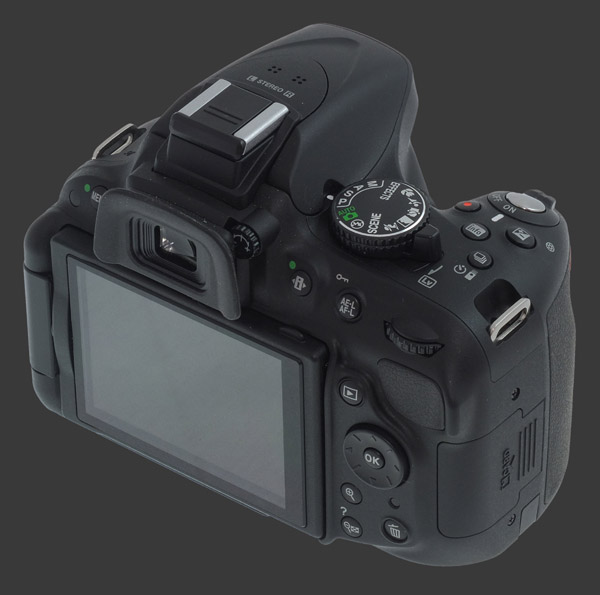
Video features have been ubiquitous on Nikon DSLRs since the D90 and the new D5200 is no exception. Full 1080p HD video up to 30 FPS can be captured with or without stereo sound. Sound is recordable from the built-in stereo microphone or an external audio-source via a standard mini-jack.
Continuous AF is available during video-capture. It is a Contrast-Detect system, so unwanted back-and-forth lens movements are a regular occurrence. One should instead rely on MF while shooting video to control lens movement and timing.
Nikon D5200 Ergonomics - How easy is it to handle?
The Nikon D5200 is one of the smallest and lightest DSLRs on the market. Its plastic construction makes it very portable and will not feel heavy unless a big lens is attached. As a consequence, the grip is rather narrow and a little short which feels cramped, particularly for people with large hands.
There is a reflex viewfinder with 95% coverage and 0.78X magnification. It is the second smallest viewfinder on an APS-C DSLR. As expected, it is dim and makes it hard to see fine-details. Not only is it tiresome, it makes it difficult to judge focus accuracy.
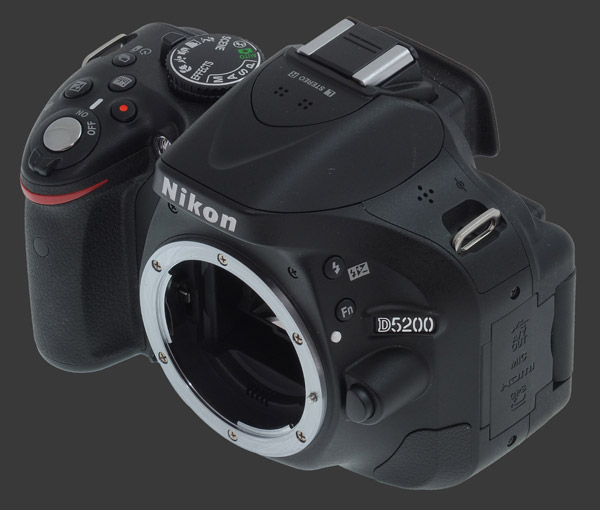
There is an unusually high number of buttons on the D5200. Unfortunately, they are underused and sometimes redundant. Very few photographic functions can be changed directly without entering the menu system or status screen. There is a reasonably-placed button for EC, plus one for FC and a customizable one which are usable with the camera at eye-level. Everything else requires the LCD to see changes.
The Function button, on the front of the camera, can be assigned one of 14 functions, including ISO, WB, HDR, Bracketing, AF-Area and AF-On. Considering there is no direct control for ISO, this is the most likely choice.
Both the mode-dial and only control-dial have nice detents with audible clicks. They give positive feedback while avoiding accidental changes. The control-dial is perfectly placed, requiring minimal movements to rotate it. Next to it is a AE-L/AF-L button which is nicely customizable.
All camera functions other than exposure-mode are accessible from the extensive menu which is organized in 6 tabs. The last one is the My Menu tab which can be filled with user-selected function. This is a great place to put Exposure Delay Mode and Self-Timer and White-Balance.
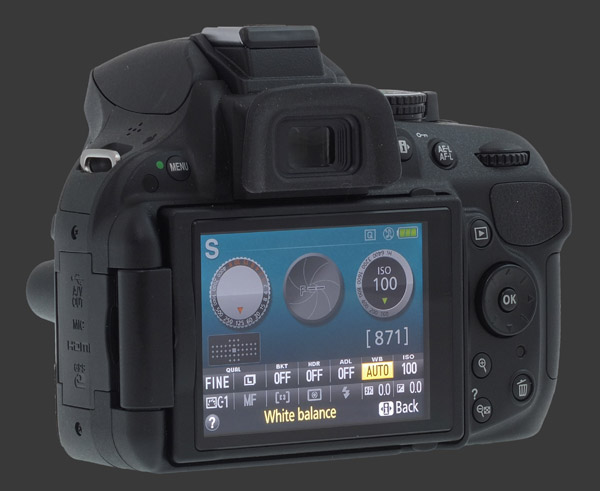
An interactive status screen is available by pressing [i] twice. On the first press, the status screen appears but is not editable, just like when pressing Info. This makes the interactive screen one click further than necessary.
Once entered, any of 14 parameters can be changed: Quality, Size, Bracketing, HDR, Adaptive D-Lighting, WB, ISO, Picture-Control, Focus Mode, Focus Area, Metering, Flash Mode, FC and EC. Note that only the primary choice of a parameter can be set here. WB can be selected but not fine-tuned and the same for Picture-Control. Fluorescent WB can be selected but not the sub-type.
Nikon makes it very easy to select the focus-point on the D5200. The 4-way controller moves the AF-point and pressing the OK button instantly brings the point back to the center. There are 39 points to choose from which cover a good amount of the frame. Points light-up red in the OVF when selected.
Build quality is acceptable. The body feels solid, including both compartment doors. The rotating LCD hinge is clearly the weakest point with some flex to it. Its design which folds outwards make it particularly vulnerable to knocks, so one has to be extra careful when it is open. On the plus side, the LCD can be folded inwards while not in use for additional protection. A metal tripod mount at the bottom is in-line with the lens center, perfect for panoramas.
About the LCD itself, it is sharp and has good visibility with an excellent angle-of-view. When most buttons are pressed, including EC and Function, it lights up which sends annoying glare into your eye. Luckily, it instantly disappears with a half-press of the shutter.
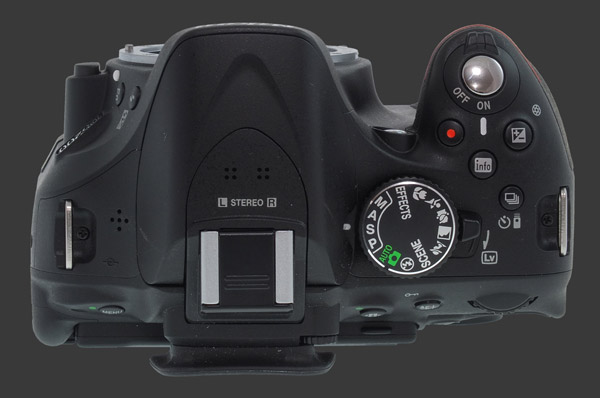
Live-View is entered by a spring-loaded lever below the mode-dial. It takes 1½s to appear. The preview shown is not Exposure-Priority and attempts to reflect the metered exposure. In good light, it manages but in low-light the preview is usually too dark. This makes it hard to use at night when MF-Assist would have been beneficial to establish critical focus. Using Live-View with an ND filter is also nearly impossible.
Oddly, some things behave more logically in Live-View. The [i] button immediately overlays the interactive status screen and Info cycles over various display modes: Normal,. Grid Lines, Detail and Movie. Movie display-mode shows the microphone meters and places a semi-transparent overlay at the top and bottom to show which area will not be captured by video. This is necessary because the D5200 lacks a video mode. This works over bright areas but not over dark ones.
Nikon D5200 Performance - How well does it take pictures?
Ultimately, it is image quality that makes a camera worth buying. For an SLR, image quality greatly depends on the lens. While color, noise, exposure and dynamic-range are properties of a camera, distortion, vignetting and chromatic aberrations are properties of the lens. Sharpness and contrast depend on the weakest link. That is, the camera cannot capture more details than the lens lets through. Conversely, it is quite possible for a lens to transmit more details than the sensor can capture.
Note that the Nikon D5200 is often sold with a kit-lens, specifically the Nikkor AF-S DX 18-55mm F/3.5-5.6G VR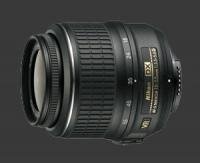
Nikkor AF-S DX 18-55mm F/3.5-5.6G VR. As this lens is of poor quality, we highly recommend to skip it buy a higher-quality one instead. The difference is clearly visible in both tests and real-world photography. Towards the long end, things are very soft until stopped down to F/11. This is right at the diffraction limit of this camera.
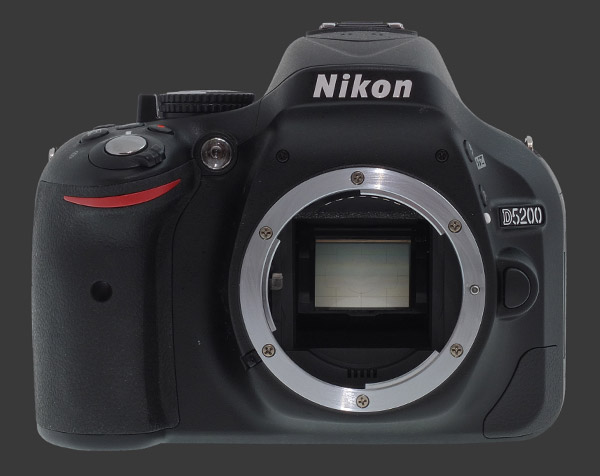
Image quality of this DSLR is good but not as solid as we are accustomed to. Image-noise is rather low which places it one stop behind the D5100 that precedes it. Although this would normally even out considering a 50% increase in megapixels, the D5200 uses aggressive noise-reduction even when disabled which smears fine-details as early as ISO 400. This reduces the resolution advantage while remaining noisier.
From ISO 100 to 800 there is virtually no visible noise in images from the D5200. By ISO 400 though, maximum print-size gets affected which is why noise-measurements alone are far from enough to describe image-quality. ISO 1600 shows a very slight increase in noise but a decrease in fine-details, reducing possible print-sizes. At ISO 3200, noise becomes easily visible but mid-size prints are still possible.
ISO 6400 is even more noisy but usable for small prints. ISO 12800 can produce small prints with recognizable subjects and remains usable for emergencies. This cannot be said about ISO 25600. Still, this is a rather nice performance for such a high-resolution APS-C camera.
The D5200 features Nikon's unique monochrome NightVision mode which boosts ISO up to 102400. At ISO 25600, which is the minimum for NightVision, details looks marginally better than normally at that sensitivity. ISO 512000 is a blurry mess and ISO 1024000 completely unusable.
The multi-segment metering system, which Nikon call Matrix, is average in accuracy. It rarely missed by more than 1 EV yet shows more frequent over and under-exposure than usual. In particular it is significantly biased towards the focus-point, so the same scene can be improperly exposed or not depending on which focus-point was chosen. This is clearly visible in Live-View where the preview brightness changes when the focus-area is moved.
Dynamic-range from the D5200 is excellent, second only to the Pentax K-5 family of DSLRs. Given this dynamic-range, the Nikon D5200 can handle most scenes with ease. A built-in HDR function allows an additional three stops of dynamic-range by combining two exposures. Depending on the blending chosen, the result can look more-or-less natural.
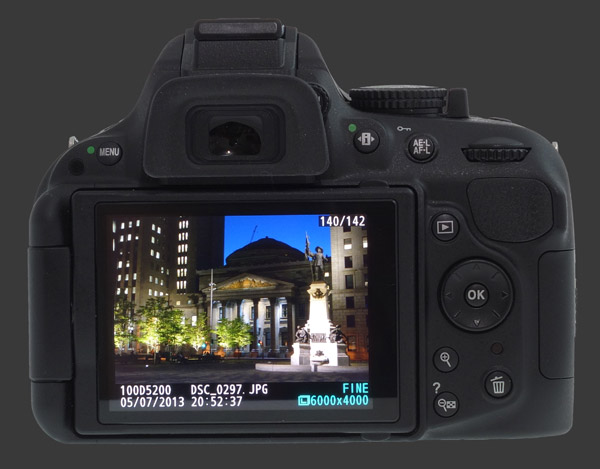
There are 6 Picture Control styles on this digital camera. The most realistic colors come from the Neutral style. That style is subdued by default, making images duller than they should be. A boost of Contrast to +1 improves things nicely. The default Sharpness of 2 is extremely soft. Going to 4 improves things a little, while 5 makes things reasonably sharp with minimal artifacts. Note that with a very high-quality lens, less sharpness may be needed.
Automatic white-balance is very good outdoors, as one would expect from a modern camera. Indoors though, the D5200 struggles more than usual. There are plenty of presets to choose from and WB Fine-Tuning can improve things considerably but finding the right settings is difficult since there is no dynamic preview of WB or Fine-Tuning, even in Live-View. When time permits, it is more reliable to use Custom WB.
It seems like the processor has not been upgraded to match the higher resolution sensor because the D5200 is rather sluggish. When buttons are pressed, the camera sometimes responds quickly. Occasionally, it takes more than one second to respond. Things get particularly slow in Playback mode.
Its performance is characterized by the following measurements:
- Power On: Instant. Excellent.
- Power Off: Instant, Excellent.
- Autofocus: As little as ¼s in good light. Over 1s with a slow lens in low-light. Very good to glacial.
- Focus Confirm: Nearly instant for both autofocus and manual focus. Very good.
- Shutter-lag: Nearly instant followed by very short black-out. Excellent.
- Shot-to-Shot Speed: About ½s with MF, around ¾s with AF. Slow.
- Instant Review: About ¾s. Below average.
- Shot-to-Shot Review: ½s. Below average.
- Playback Mode: ¼s. Good.
- Shooting Mode: ¼s. Good.
This is probably the most variable performance every seen. Some numbers are excellent while others plainly slow. Autofocus itself is extremely variable. It can lock focus in ¼s but it can also take over 1s with a slow-lens. Expect this kind of variation because the D5200 relies on lenses with a focus-motor built-in and those can be quite different.
Shot-to-shot speeds are disappointing. The instant shutter-lag, followed by a nearly unnoticeable black-out, is actually impressive. When combined with the 5 FPS continuous drive, this camera can follow action respectably as long as there is enough light to focus quickly.
Nikon D5200 Conclusion
While externally identical to its predecessor, the Nikon D5200 increases resolution to 24 megapixels and, most importantly, introduces a 39-point autofocus sensor with 9 cross-type points. This is a first for an entry-level SLR and gives an edge for action-photography where more points make it easier to track moving subjects.
The Nikon D5200 offers slightly more than the typical feature-set of entry-level DSLRs yet, despite having a good number of buttons, does not provide efficient access to its features. For mostly automatic use, the Nikon D5200 handles reasonably well. The body is small and light which helps with portability.
Image-quality of the D5200 is good but not up to par with recent offerings. Noise is still low but with a smearing of details starting at ISO 400 which negates some of the resolution advantage of this digital camera. Common print-sizes though can be made through ISO 3200 while higher sensitivities should be reserved for small prints. Dynamic-range is excellent and there is little to complain about colors.
Metering and white-balance are somewhat below average. It seems the D5200 is given too much emphasis around the focus-point which skews things and causes more over-exposure than usual. WB is good outdoors but struggles under artificial light. A custom white-balance option can avoid the issue but requires more work which is less than ideal for the audience of this DSLR.
Performance is surprisingly mixed with the D5200. Luckily the shutter-lag is nearly instant and autofocus speed can be fast but becomes glacial with a slow-lens, even more so in low-light. For outdoor action, using a bright telephoto lens, the D5200 should perform well. For indoor action, it will suffer in performance though.
The bottom line is that there is a lot to like about the D5200, most notably the new 39-point AF system, compact size and good set of video features. Like all Nikon DSLRs, it allows the use of one of the largest lens lineups in the industry, albeit not always with autofocus.
 |
Please Support Neocamera
All information on Neocamera is provided free of charge yet running this website is a huge endeavor. Purchases made via affiliate links found throughout the site help keep it running and up-to-date. There is no additional cost to you, so please consider buying via these links to our affilates:
Thank you for your support!
Nikon D5200 Highlights

Sensor-Size: 24 x 16mm

Actual size when viewed at 100 DPI
| 24 Megapixels DSLR | ISO 100-25600 |
| Nikon F Mount 1.5X FLM | Shutter 1/4000-30s |
| 95% Coverage Small Viewfinder | Full manual controls, including Manual Focus |
| Built-in Dust Reduction | Custom white-balance with 2 axis fine-tuning |
| 5 FPS Drive, 100 Images | Spot-Metering |
| 1920x1080 @ 30 FPS Video Recording | Hot-Shoe |
| 3" LCD 920K Pixels | Stereo audio input |
| Lithium-Ion Battery | |
| Secure Digital Extended Capacity |
Updates
2025.11.13

Best Gifts for Photographers in 2025 by Budget
The annual Neocamera Photography Gift Guide updated to 2025. Find great gifts for photographers with any price budget.
2025.07.07

Stellar Photo Recovery Review
Review of Stellar Photo Recovery V12. This Windows and MacOS software can recover photos and videos in a huge number of formats from memory cards, USB drives, SSDs and HHDs.
2025.05.14

Huion Kamvas 13 Gen 3 Review
In-Depth review of the Huion Kamvas 13 Gen 3 Pen Display Tablet for photographers and graphic artists.
2025.01.18

Fujifilm GFX 2025 Lens Roundup
Lens Review roundup of Fujifilm GFX Medium-Format lenses. Quality, performance and handling of the GF20-35mm F/4R WR, GF30mm F/3.5 Tilt-Shift and the GF55mm F/1.7.
2024.11.18

Best 2024 Photography Gifts for Every Budget
Great gifts for photographers and photo enthusiasts selected for every budget among the best products of 2024.
2024.08.07

Eye Protection Tips for Professional Photographers
The four main considerations for professional photographers regarding eyewear.
2024.07.14

Fujifilm X100VI Review
Flagship fixed-lens compact digital camera with a 40 MP sensor and Image-Stabilization, a first for the series. Retro design featuring dual control-dials, plus direct ISO, Shutter-Speed and EC dials. Its hybrid viewfinder can switch between EVF and OVF mode.
2024.05.09

Fujifilm GFX100 II Review
Flagship 102 Megapixels Medium-Format Mirrorless Digital Camera with 8-Stop 5-Axis IBIS, 8 FPS Drive, 8K Video and 400 MP Super-Resolution capture in a weatherproof and freezeproof body with dual control-dials and dual memory-card slots.
2024.04.03

Fujifilm X-T5 Review
Newest Fujifilm flagship boasting a 40 MP APS-C sensor, 5-axis IBIS with 7-stop efficiency, 15 FPS continuous drive, 6.2K Video capture, dual control-dials and dual SDXC UHS-II slots in a sturdy weatherproof and freezeproof body.
2023.11.20

Best Digital Cameras of 2023
Find out which are the Best Digital Cameras of 2023. All the new Mirrorless Digital Cameras from entry-level to high-end professional.
2023.07.10

Fujifilm X-H2 Review
40 Megapixels APS-C Hybrid Mirrorless Digital Camera with 7-stop IBIS. Fastest shutter ever and 8K video capture. Large builtin EVF with 0.8X magnification and 5.8 MP, plus an Eye-Start Sensor. Packed with features and large number of controls in a weatherproof and freezeproof body.
2023.05.07

Sony FE 20-70mm F/4G Review
Review of the unique Sony FE 20-70mm F/4G lens. The optical zoom of this lens spans ultra-wide-angle and medium focal-length coverage, making it one of the most versatile Full-Frame lenses on the market.












